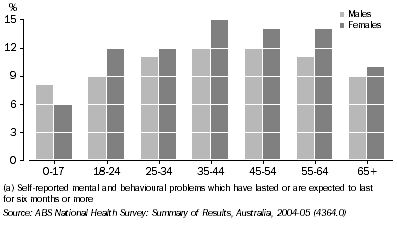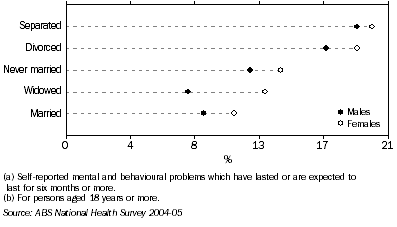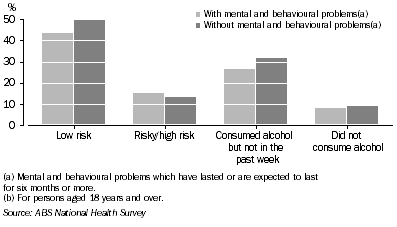|
|
NOTES
INTRODUCTION
This article provides a brief overview of the prevalence, risk factors and characteristics of persons with mental or behavioural problems in Australia.
DATA SOURCES
Unless otherwise stated, this article presents information sourced from the 2004-05 ABS National Health Survey (NHS). It should be noted that the 2004-05 NHS excluded persons in hospitals, nursing and convalescent homes and hospices and hence the data relates only to persons in private dwellings. This article also draws on data from the 2003 Survey of Disability, Ageing and Carers (SDAC) and other ABS and non-ABS sources.
Mental or behavioural problems were identified in the 2004-05 NHS through the self-reported information on long-term conditions obtained by the survey (footnote 1). However, unlike other conditions such as cancer, cardiovascular conditions, diabetes and asthma, respondents in the survey were not specifically asked whether they had been diagnosed with any mental disorders. Therefore the information provided by respondents may have been based on self-diagnosis rather than diagnosis by a health professional. The proportions of the population with specific mental or behavioural problems are also small. Analysis in the article is therefore confined to the broader level of mental health conditions.
The Kessler Psychological Distress Scale-10 (K10) is used as a measure of non-specific psychological distress experienced in the last four weeks. A very high level of psychological distress, as shown by the K10, may indicate a need for professional help (footnote 2).
The 1997 National Survey of Mental Health and Wellbeing of Adults (SMHWB) provides information on the prevalence of a range of mental or behavioural problems based on diagnostic criteria. While the last SMHWB was held in 1997, it is expected to be updated in 2007.
INQUIRIES
For further information about these and related statistics, contact the National Information and Referral Service on 1300 135 070 or email <client.services@abs.gov.au>.
MENTAL HEALTH
Good mental health is fundamental to the wellbeing of individuals, their families, and the whole population. Conversely, mental health problems and mental illness are among the greatest causes of disability, diminished quality of life, and reduced productivity. People affected by mental health problems often have high levels of morbidity and mortality, experiencing poorer general health and higher rates of death from a range of causes, including suicide. These conditions are significant in terms of prevalence and disease burden, and have far-reaching impacts for families, carers and others in the community (National Mental Health Plan 2003-08).
In 2003, mental illnesses were among the ten leading causes of disease burden in Australia, accounting for 13% of the total burden of disease (AIHW 2006a).
Long-term mental and behavioural problems include:
- Anxiety disorders (includes panic disorder, agoraphobia, social phobia, generalised anxiety disorder (GAD), obsessive-compulsive disorder (OCD) and post-traumatic stress disorder (PTSD))
- Mood (affective) disorders (includes depression, dysthymia, mania, hypomania and bipolar affective disorder)
- Alcohol use disorders (includes harmful use and dependence)
- Drug use disorders (includes harmful use and dependence)
A higher score on the Kessler Psychological Distress Scale (K10) indicates a higher level of distress based on questions about negative emotional states in the four weeks prior to interview.
PREVALENCE
- In 2004-05, 11% of all persons reported they currently have a long-term mental or behavioural problem.
- In the 1997 National Survey of Mental Health and Wellbeing of Adults (SMHWB), which is based on diagnostic criteria rather than self report, almost one in five adults (18%) had a mental disorder at some time during the twelve months prior to the survey.
- Half (50%) of all persons reporting mental and behavioural problems in the 2004-05 NHS had mood (affective) problems, and 46% had anxiety related problems.
- The proportion reporting a long-term mental or behavioural problem has increased over the last three National Health Surveys. In 1995 the proportion was 5.9%, in 2001 it was 9.6% and in 2004-05 it was 11.0% (after adjusting for age differences) (footnote 3). This may reflect an increased willingness to report mental disorders.
- In 2004-05, 13% of all adults reported experiencing high/very high levels of psychological distress in the last four weeks.
- Psychological distress was first collected from adults in the NHS in 2001. Similar levels of high/very high levels of psychological distress were reported by adults in the 2001 and 2004-05 surveys, at 12.6% and 13.0% respectively (after adjusting for age differences).
AGE AND SEX
- Females were more likely than males to report a long-term mental or behavioural problem in 2004-05 (11.4% of females compared to 10% of males).
- Women were also more likely to report high/very high levels of psychological distress than men (15% compared to 10%).
- In 2004-05 females reported higher rates than males for mental or behavioural problems overall in each five-year age group, with the exception of those aged under 18 years and those aged over 75 years.
- In 2004-05, 7% of people aged 0-17 years reported mental or behavioural problems. The prevalence of mental or behavioural problems generally increased with age until the 35-44 year age group, with 14% of people aged 35-44 reporting a mental or behavioural problem. The prevalence of mental or behavioural problems then declined to 10% of people aged 75 years and over.
- In the 1997 Survey of Mental Health and Wellbeing, young adults aged 18-24 years had the highest prevalence of mental disorders (27%) The prevalence decreased by age to 5.5% of those aged 65 years and over (ABS 1997).
- In 2004-05, problems of psychological development (2.8%) and emotional and behavioural problems with usual onset in childhood/adolescence (3.0%), were most prevalent among those aged 0-17 years.
- Organic mental health problems (including etiology in cerebral disease, brain injury or other trauma leading to cerebral dysfunction and dementia) were more prevalent among those 75 years and over in 2004-05 (affecting 1.9%), than among those aged 65-74 years (affecting 0.2%).
Prevalence of mental and behavioural problems (a)

MARITAL STATUS
- In 2004-05, among those aged 15 and over, mental or behavioural problems were most commonly reported by those who were separated (20% of males and 20% of females) or divorced (17% of males and 19% of females). Married persons reported lower rates of mental or behavioural problems (9% of males and 11% of females).
- High/very high levels of psychological distress were reported more frequently by adults who were separated (22%) and divorced (18%) than by adults who were married (9%).
- Women aged 18 and over who were separated had a high prevalence of a high/very high level of psychological distress (25%). The lowest rates of a high/very high level of psychological distress were among married men (9.4%).
Prevalence of mental and behavioural problems (a)(b), by marital status

SOCIOECONOMIC STATUS
- Adults who lived in the most socioeconomically disadvantaged areas experienced a higher prevalence of mental or behavioural problems (16%) compared with people who lived in the least socioeconomically disadvantage areas (9%) (as measured by being in the lowest and highest quintiles of the index of disadvantage respectively) (footnote 4).
- Similarly, adults aged 18 years and over living in the most socioeconomically disadvantaged areas were more likely to report a high/very high level of psychological distress (20%) compared with those living in the least socioeconomically disadvantaged areas (8.0%).
DISABILITY
- In the 2003 Survey of Disability, Ageing and Carers, 11% of persons with a disability reported having a mental or behavioural problem (footnote 5) (ABS 2004).
- Psychoses and mood (affective) disorders were the most common group of mental disorders among people reporting a disability, affecting 5.3% of persons reporting a disability and 15% of persons with profound core-activity limitations in 2003 (footnote 6) (ABS 2004).
- Of those with a mental or behavioural problem in 2003, 45% reported profound or severe core-activity limitations, 29% reported moderate or mild core-activity limitations and 59% reported schooling or employment restrictions (footnote 7) (ABS 2004).
- In 2003, mental disorders accounted for 13% of total disability adjusted life years (DALY) (footnote 8).
HEALTH STATUS
- In 2004-05, people aged 15 years and over with mental or behavioural problems were three times more likely to report fair/poor health than those without mental or behavioural problems (36% compared with 14%). Persons with mental or behavioural problems were less likely to report very good/excellent health than those without mental or behavioural problems (34% compared with 58%).
RISK FACTORS
Mental health problems are associated with increased exposure to health risk factors, which in turn lead to the increased risk of poor physical health. These include health behavioural risk factors such as alcohol consumption, tobacco use and physical inactivity (AIHW 2006a).
Alcohol consumption
- Adults reporting mental or behavioural problems in 2004-05 were more likely than those without such problems to drink at a level which is risky/high risk in the long term (15% compared with 13%) (footnote 9).
Alcohol risk level in the long term (a)(b),

Tobacco smoking
- Of adults reporting mental or behavioural problems in 2004-05, 32% reported being current daily smokers compared with 20% of those without mental behavioural problems.
- In 2004-05, adults reporting a high/very high level of psychological distress were more likely to be current daily smokers (35%) than were those with a moderate level (25%) or low level (17%) of psychological distress.
Physical inactivity
- In 2004-05, 75% of those with mental and behavioural problems aged 15 and over had low levels of exercise (sedentary or low exercise level), compared to 69% of those without mental and behavioural problems (footnote 10).
- Similarly, those persons with a high/very high level of psychological distress were more likely than those with a low level of psychological distress to report being physically inactive (48% compared with 31%).
MEDICATIONS
- In 2004-05, 19% of adults reported that they had used some medication (pharmaceutical medication and/or vitamins, minerals or herbal treatments) for their mental wellbeing in the fortnight prior to the 2005-05 NHS interview. (ABS 2006b).
- Of those using medications for mental wellbeing, 27% reported using anti depressants, 23% used sleeping tablets and 10% used medications for anxiety or nerves. (ABS 2006b).
- Use of medications was higher among females than males overall (24% and 14% respectively).
- Use of medications was higher overall in older age groups and this was largely due to higher use of sleeping medications (11% of persons aged 65 years and over compared with 5% for the whole adult population) (ABS 2006b). In this older age group, the use of sleeping tablets or capsules in the last two weeks was reported by almost half of those using medication for mental wellbeing.
HEALTH SYSTEM COSTS
- While mental health-related separations accounted for 4.5% of all hospital separations in 2003-04, they accounted for 12% of total days spent by patients in hospitals (AIHW 2006a).
- In 2004-05, principal diagnoses of depressive disorders (36%), neurotic and stress-related disorders (17%), mental and behavioural disorders due to alcohol (12%) and schizophrenia (11%) accounted for the largest proportions of mental health related hospital separations (AIHW 2006b).
- Expenditure on mental health services ($3.0 billion) (footnote 11) accounted for 6.0% of all health expenditure in 2000-01 (AIHW 2004).
- In 2003-04, expenditure on all hospital services (public and private) accounted for 34.8% of total recurrent health expenditure. Of this expenditure on hospital services, 2% was for public psychiatric hospitals (AIHW 2006a).
FOOTNOTES
1. A long term condition is a current condition which has lasted or was expected to last for six months or more. Back
2. In the 2004-05 NHS, the K10 questions were asked of adults aged 18 years and over. For more information on the K10, see Australian Bureau of Statistics, Information Paper - Use of Kessler Psychological Distress Scale in ABS Health Surveys, 2003, cat. no. 4817.0.55.001, ABS, Canberra. Back
3. Since many health characteristics are age-related, the age profile of the populations being compared needs to be considered when interpreting the data. To account for the differences in age structure, where noted, some estimates within this publication are shown as age standardised percentages, using the Australian estimated resident population at June 30 2001 as the standard population. For further detail, see the Explanatory Notes of the National Health Survey: Summary of Results, 2004–05 (cat. no. 4364.0). Back
4. The Index of disadvantage is one of four Socio Economic Indexes for Areas (SEIFAs) compiled by ABS following each Census of Population and Housing. The indexes are compiled from various characteristics of persons resident in particular areas; the index of disadvantage summarises attributes such as low income, low educational attainment, high unemployment and jobs in relatively unskilled occupations. For further information about SEIFAs see Chapter 6 of the 2004-05 National Health Survey: Users' Guide. Back
5. Excludes intellectual and developmental disorders. Back
6. Core activities comprise communication, mobility and self care. Back
7. Total does not add up to the sum of the components as persons may have both a core-activity limitation and a schooling or employment restriction. Back
8. DALY refers to years of healthy life lost through premature death or living with disability due to illness or injury. DALYs are used to measure the burden of disease which includes both morbidity and mortality. It is a combination of years of life lost due to premature mortality (YLL) and the equivalent years of 'healthy' life lost due to poor health or disability (YLD). Back
9. In the 2004-05 NHS, persons aged 18 years and over were classified to a long-term health risk level (low risk, risky or high risk) based on their reported estimated average daily consumption of alcohol during the week prior to the NHS interview. For long-term risk for males an average daily consumption of up to 4 standard drinks is considered 'low risk', 5-6 'risky' and 7 or more 'high risk'; for long-term risk for females, an average daily consumption of up to 2 standard drinks is considered 'low risk', 3-4 'risky' and 5 or more 'high risk'. Back
10. Exercise level categories representing the intensity of reported exercise were derived based on frequency, intensity and duration of exercise. Sedentary exercise refers to less than 100 minutes of exercise (includes no exercise). Low exercise refers to 100 minutes to less than 1,600 minutes. Back
11. Excludes expenditure on nervous system disorders such as Alzheimer's disease and other dementias and excludes expenditure on community mental health services. Back
LIST OF REFERENCES
Australian Bureau of Statistics 2006a, National Aboriginal and Torres Strait Islander Health Survey, 2004-05, cat. no. 4715.0, ABS, Canberra.
Australian Bureau of Statistics 2006b, National Health Survey: Summary of Results, Australia, 2004-05, cat. no. 4364.0, ABS, Canberra.
Australian Bureau of Statistics 2004, Disability, Ageing and Carers: Summary of Findings, Australia, 2003, cat. no. 4430.0, ABS, Canberra.
Australian Bureau of Statistics 1997, Mental Health and Wellbeing: Profile of Adults, Australia, 1997, cat. no. 4326.0, ABS, Canberra.
Australian Health Ministers 2003, National Mental Health Plan 2003-08, Australian Government, Canberra.
Australian Institute of Health and Welfare 2006a, Australia's Health 2006, AIHW Cat. No. AUS 73, AIHW, Canberra.
Australian Institute of Health and Welfare 2006b, Hospital Morbidity Database, Separation, patient day and average length of stay statistics by principle diagnosis in ICD-10-AM, Australia, 1998-99 to 2003-04, viewed 15 July 2006,www.aihw.gov.au/cognos/cgi-bin/ppdscgi.exe?DC=Q&E=/AHS/principaldiagnosis0304
Australian Institute of Health and Welfare 2004, Australia's Health 2004, AIHW Cat. No. AUS 44, AIHW, Canberra.
|
|
 Print Page
Print Page
 Print All
Print All